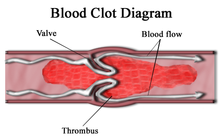
Back خثرة Arabic Тромб Byelorussian Dara ganting BEW Тромб Bulgarian Krvni ugrušak BS Coàgul sanguini Catalan Blodprop Danish Thrombus German Θρόμβος Greek Trombo Esperanto
| Thrombus | |
|---|---|
| Other names | Blood clot |
 | |
| Diagram of a thrombus (blood clot) that has blocked a vein valve | |
| Specialty | Vascular surgery |
| Symptoms | abrupt change in mental status, chest pain, cramp-like feeling, fatigue, passing out (syncope), and swelling in the arm and/or leg |
| Complications | bleeding risks from taking anticoagulants, breathing problems, heart attacks, stroke |
| Duration | c. 3–6 months |
| Types | Superficial thrombophlebiti and Thrombophlebitis migrans |
| Causes | injury to the artery, sepsis or viral infection, immobility |
| Risk factors | hospitalization, immobility, obesity, pregnancy, physical trauma |
| Diagnostic method | magnetic resonance angiography, ultrasound, and venography |
| Prevention | smoking cessation, regular exercise, improved blood flow, management of comorbidities |
| Treatment | Anticoagulants: edoxaban, tinzaparin, unfractionated heparin |
| Medication | apixaban, edoxaban, and rivaroxaban |
| Deaths | 100,000–300,000 each year |
A thrombus (pl.: thrombi), colloquially called a blood clot, is the final product of the blood coagulation step in hemostasis. There are two components to a thrombus: aggregated platelets and red blood cells that form a plug, and a mesh of cross-linked fibrin protein. The substance making up a thrombus is sometimes called cruor. A thrombus is a healthy response to injury intended to stop and prevent further bleeding, but can be harmful in thrombosis, when a clot obstructs blood flow through healthy blood vessels in the circulatory system.
In the microcirculation consisting of the very small and smallest blood vessels the capillaries, tiny thrombi known as microclots can obstruct the flow of blood in the capillaries. This can cause a number of problems particularly affecting the alveoli in the lungs of the respiratory system resulting from reduced oxygen supply. Microclots have been found to be a characteristic feature in severe cases of COVID-19 and in long COVID.[1]
Mural thrombi are thrombi that adhere to the wall of a large blood vessel or heart chamber.[2] They are most commonly found in the aorta, the largest artery in the body, more often in the descending aorta, and less often in the aortic arch or abdominal aorta.[2] They can restrict blood flow but usually do not block it entirely. They appear grey-red along with alternating light and dark lines (known as lines of Zahn) which represent bands of white blood cells and red blood cells (darker) entrapped in layers of fibrin.[3]
- ^ Pretorius E, Vlok M, Venter C, Bezuidenhout JA, Laubscher GJ, Steenkamp J, Kell DB (August 2021). "Persistent clotting protein pathology in Long COVID/Post-Acute Sequelae of COVID-19 (PASC) is accompanied by increased levels of antiplasmin". Cardiovasc Diabetol. 20 (1): 172. doi:10.1186/s12933-021-01359-7. PMC 8381139. PMID 34425843.
- ^ a b Singh, Davinder P.; Basit, Hajira; Malik, Ahmad; Mahajan, Kunal (5 November 2021). "Mural Thrombi". PMID 30484999. Retrieved 11 February 2022.
- ^ Karaolanis G, Moris D, Bakoyiannis C, Tsilimigras DI, Palla VV, Spartalis E, Schizas D, Georgopoulos S (August 2017). "A critical reappraisal of the treatment modalities of normal appearing thoracic aorta mural thrombi". Ann Transl Med. 5 (15): 306. doi:10.21037/atm.2017.05.15. PMC 5555985. PMID 28856146.
© MMXXIII Rich X Search. We shall prevail. All rights reserved. Rich X Search